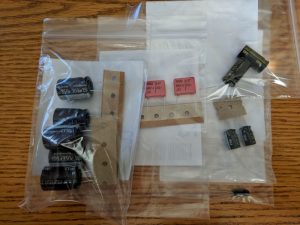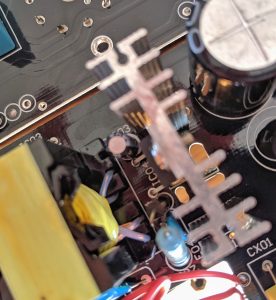I can’t say I was entirely surprised, but the TubeCube started acting up. I normally have it turn on with the rest of my desk–I have a remote switch which turns on the lights, TubeCube and DAC. I noticed the tubes would not light up until maybe 10-15 minutes later. As the next couple of weeks went on, it would take an hour or two for the tubes to light up. Finally, it quit turning on altogether.
Crap. The audio circuitry is dead simple, but the power supply? Forget it. It is a switching power supply which utilizes all sorts of SMDs (surface mount devices) that are impossible for me to work on.
I did notice that the capacitors in this unit were all off-brand chinese capacitors. Some were labeled Chong, and I couldn’t help but think of them going “up in smoke.” At any rate, I had read elsewhere that there were two pairs of capacitors in the audio circuit that could stand improvement by changing the values–the cathode capacitor, and the coupling capacitor.
Armed with that idea, and a set of calipers, I went to examining all of the electrolytic caps in this amp. I figured that I wanted to upgrade those two pairs of audio caps, but with the problem I was having, for not much additional money, I could replace all of them with quality Nichicon caps.

I built up my order at Mouser, had it shipped, and went about replacing the caps. Upon closer inspection as I began removing the old caps, I noticed that I missed one!! A tiny cap tucked behind two large ones, against the side of the case. And I figured that with my luck, that one might be the capacitor causing the problem. I tested it in place, and got a reading close enough to its nominal value. Crisis averted.
Upon removing the original caps, I took to measuring them with the multimeter. Every one of them was at the very low end of the ±20% tolerance range…just barely within tolerance. One cap in particular, though, was far out of range, and was (if I recall) about 25%-27% out of range on the low side. And, that was a cap that was located right next to the IC that is essentially the “brains” of the switching power supply, which is mounted to a heatsink.
So, I soldered in all the new caps. All Nichicons, except that one pair in the audio circuit were Nichicon Muse caps (their audiophile series), and the other pair was WIMA film caps. Reassembled the case. Plugged everything in.
It worked.

My only issue now is that one of my reissue Mullards is getting a little noisy–the left channel occasionally makes a rustling sound, which stops when I tap on the left EL84. Ah well. At least it’s working, and if/when that tube gets annoyingly worse, I’ll pick up a new pair.
I also want to pick up a different 12AX7. This amp ships with a rolled off high end. The capacitors unfortunately did not change the severe rolloff in the highs, and I noticed almost no change in the sound after replacing all the capacitors. I am writing this off as a design flaw.
Project completed, though. It’s doing nightly duties for anywhere from 4-6 hours. And it still looks cool up on the desk…